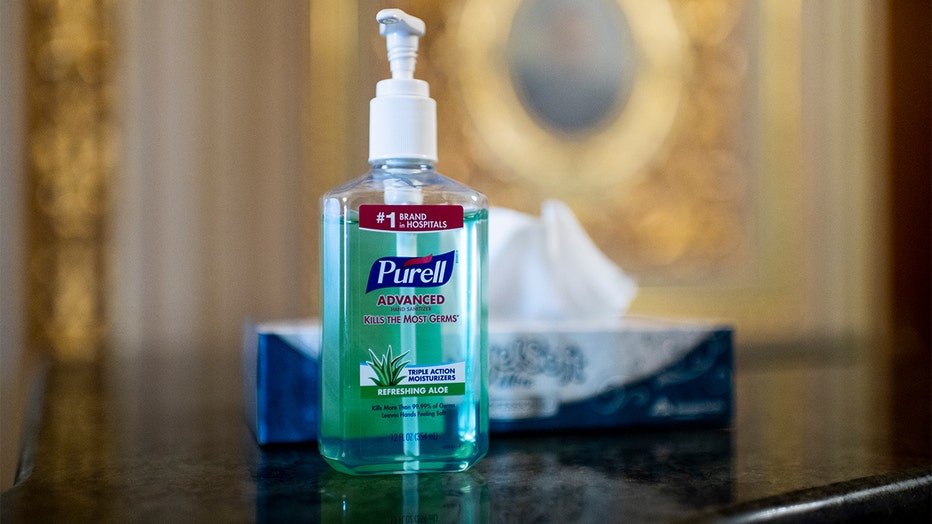Can’t find hand sanitizer? The World Health Organization has a recipe to make your own

Self-quarantine tips for those infected or at risk of the coronavirus
Wearing face masks and not sharing personal items are key to maintaining strong health.
LOS ANGELES - Fear of the novel coronavirus has led people to stock up on germ-killing gel, leaving store shelves empty and online retailers with sky-high prices set by those trying to profit on the rush. More is said to be on the way, although it's not clear how long it will take retailers to restock.
Sales of hand sanitizers in the U.S. were up 73% in the four weeks ending in Feb. 22 compared to the same period a year ago, according to market research firm Nielsen.
RELATED: Looking for hand sanitizer? Good luck finding it
While these products are becoming more and more scarce in the face of the growing COVID-19 outbreak, the World Health Organization has an available recipe guide for how to make alcohol-based handrub formulas recommended by the organization.
WHO’s recipe for DIY hand sanitizer may seem like a last-ditch measure, and while many of the ingredients needed to make the formulas at home may appear unconventional, they can actually be purchased online or at a local pharmacy.
“It is the consensus opinion of a WHO expert group that WHO recommended handrub formulations can be used both for hygienic hand antisepsis and for presurgical hand preparation,” the WHO said.
WHO has provided two formulas differing in their alcohol bases, should one not be available.

A box of tissues and a bottle of Purrell hand sanitizer sit on the desk. (Photo By Bill Clark/CQ-Roll Call, Inc via Getty Images)
RELATED: Should you cancel your trip? CDC urges travelers to avoid several countries impacted by coronavirus
According to WHO, these alcohol-based handrubs are a known means for rapidly and effectively inactivating a wide array of potentially harmful microorganisms on hands. The Centers for Disease Control and prevention recommends using a hand sanitizer with at least 60 percent alcohol.
Here is everything you need to create your own hand sanitizer, according to WHO:
- Ethanol 96% or isopropyl alcohol 99.8%: 8333 ml or 2.2 gallons of ethanol or 7515 ml or 2 gallons of isopropyl alcohol
- Hydrogen peroxide 3%, which is used to inactivate contaminating bacterial spores in the solution and is not an active substance for hand antisepsis: 417 ml or 1.76 cups
- Glycerol 98%, which acts as a moisturizer: 145 ml or 0.6 cups
- Sterile distilled or boiled cold water
The actual materials you’ll need to mix the ingredients include:
- Depending on how much you want to make, you’ll need anywhere from a 10-liter (2.6 gallon) glass or plastic bottle to 50-liter (13.2 gallon) plastic tank.
- Wooden, plastic or metal paddles for mixing
- Measuring cylinders and measuring jugs
- Plastic or metal funnel
- An alcoholometer
The recipe provided by the organization can be prepared in 10-liter glass or plastic bottles with screw-threaded stoppers to prevent spillage.
Here is the step by step preparation, according to WHO:
- The alcohol for the formula to be used is poured into the large bottle or tank up to the graduated mark.
- Hydrogen peroxide is added using the measuring cylinder.
- Glycerol is added using a measuring cylinder. As glycerol is very viscous and sticks to the wall of the measuring cylinder, it should be rinsed with some sterile distilled or cold boiled water and then emptied into the bottle/tank.
- The bottle/tank is then topped up to the 10-liter mark with sterile distilled or cold boiled water.
- The lid or the screw cap is placed on the tank/bottle as soon as possible after preparation, in order to prevent evaporation.
- The solution is mixed by shaking gently where appropriate or by using a paddle.
- Place the solution in quarantine for 72 hours before use. This allows time for any spores present in the alcohol or the new/re-used bottles to be destroyed.
The Associated Press contributed to this story.

